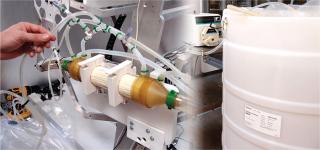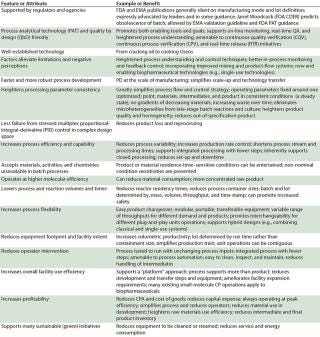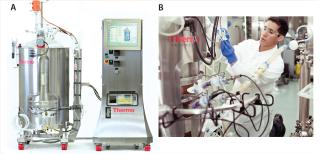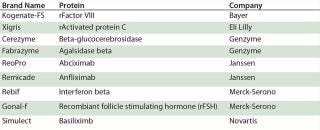Supporting Continuous Processing with Advanced Single-Use TechnologiesSupporting Continuous Processing with Advanced Single-Use Technologies
April 1, 2013
It has been 10 years since the US Food and Drug Administration (FDA) articulated — in its guidance for process analytical technology (PAT) — the goal of “facilitating continuous processing to improve efficiency and manage variability” (1). Since that time, regulators and industry have worked toward applying continuous processing (CP) to all facets of pharmaceutical manufacturing, including bioproduction (2, 3). Last year, the European Medicines Agency (EMA) referred to CP in its draft Guideline on Process Validation, and the FDA released a strategic plan, Advancing Regulatory Science, which includes an advocacy of CP (4, 5). In 2012, Genzyme (a subsidiary of Sanofi), a major player in the single-use systems (SUS) arena, reported on the development of an integrated continuous bioprocessing approach as a potential universal platform for manufacturing protein biologicals (6). And just this year, Amgen and GlaxoSmithKline announced significant commitments to CP in an effort to improve efficiency and reduce costs (7, 8).
Photo 1:

Photo 1: ()
Continuous Processing Overview
In CP manufacturing, raw materials constantly flow in and out of equipment and are continually processed into an intermediate or final product. In pharmaceutical manufacturing, that process is generally accomplished in a chemical reactor or bioreactor. The CP method is in contrast to discontinuous “batch” production, in which a specific quantity of drug is produced in a single, discrete volume during the same cycle of manufacture. Batch production is frequently segmented into many individual steps that are often performed at separate facilities (suites, buildings, or cities).
In CP, production occurs at a single location, without interruption. It proceeds in that way for variable lengths of time — from days to months to years — and is only interrupted for such reasons as cleaning of equipment or the incremental deterioration of enzymes, catalysts, or cultures.
CP is a well-established approach and is in fact a fundamental component of modern manufacturing. From detergents to paper, many products we use daily are manufactured using CP methods. The food industry, for example, proudly promotes its linear factories in which materials are continually trucked in at one end as product comes out the other. CP is also referred to as continuous production, continuous flow processing, and continuous manufacturing. It is helpful to know that many distinctions in particular implementations can be made (Table 1). Some approaches even define semicontinuous or pseudocontinuous processes.
Table 1: Approaches to continuous processing in bioproduction (some with overlapping features)

Table 1: Approaches to continuous processing in bioproduction (some with overlapping features) ()
Single-Use Technology
Single-use technologies (SUTs) are part of a maturing field, especially in upstream bioprocessing. SUTs not only support many unit operations but are increasingly available in a variety of system implementations from a growing number of vendors (9, 10). SUTs were rapidly accepted by the biopharmaceutical industry because of the numerous features they provide, including
reduced contamination risks
lower initial investment costs
lower facility and operating costs
speed, efficiency, and flexibility.
During the past 10 years, the number of operations supported by SUTs and entire systems has grown to include such activities as
cell culture in seed expansion and production
media and buffer mixing, preparation, and storage
process fluid filtration, collection, and shipping
chromatography, centrifugation, and fill–finish.
Many attributes of SUT complement and expand the features CP methods such as in perfusion cell culture (11, 12).
CP and SUTs in Pharmaceutical Production
Because the biopharmaceutical industry operates in such a highly regulated environment, it’s important to first establish that, as with SUTs, CP is supported by regulatory agencies in general. Janet Woodcock (FDA’s CDER director) has expressly predicted the obsolescence of batch processing in favor of a CP approach to pharmaceutical manufacturing (13). Along with increased monitoring, automated process control, and new statistical approaches, CP is one of the main goals of quality by design (QbD). As such, it is supported by the FDA’s initiatives for flexible regulatory approaches and science-derived quality and control specifications.
Although the development of a CP approach is now actively supported by regulators, current FDA and EMA regulations and guidances are generally neutral (silent) on existing modes of manufacturing — and accommodating in the means of lot definition. Historically, the implementation of CP in pharmaceutical manufacturing has suffered from distinct misunderstandings and in some few cases actual impediments. Concerns arose regarding performance reliability, validation complexity, and process control (14). But for many processes, previous limitations — or their perception — are being alleviated by advances in processing technology (15), process understanding, reactor monitoring, and feedback control (16, 17). An objective and thorough analysis requires a number of physical, operational, quality, temporal, economic, and even environmental parameters to be considered (Table 2). The best approaches to fit and benefit analysis include a comprehensive overall ranking strategy that takes into account the most current technologies using a multiattribute risk-based approach (11). For many applications, the greatest remaining hesitation pertains to higher-level process control for concatenated unit operations.
Table 2: Continuous processing in pharmaceutical manufacturing

Table 2: Continuous processing in pharmaceutical manufacturing ()
In manufacturing process development (PD), CP has contributed to a faster, cheaper, and more robust approach to many operations and processes than such traditional discontinuous modes as batch or fed-batch could provide. CP places less demand on material use in PD because of
reduced reaction volumes modeling or actually representing manufacturing scale
CP time-controlled materials mass consumption.
Because PD changes with the scale of manufacturing for many CP implementations, many issues in technology transfer are prevented and scale-up concerns reduced or even eliminated. For example, a CP reactor operate very economically for a few hours for PD, and that same unit can later provide “large-scale” production by simply operating it for weeks to months on a manufacturing floor. Many CP based processes can accept activities or chemistries unavailable in the more episodic batch-style manufacturing. Some previously unavailable reactor residency time–sensitive processes may even be entertained.
Consider a product that breaks down at conditions of formation. A CP approach may get that product out of the reactor before it is compromised. In some circumstances, such advantages can even contribute to increased operator safety.
CP is supported by ongoing technological developments in mixing and mass-flow systems and (even more important) by the many recent advances in process monitoring and feedback control. It’s clear how the introduction of SUTs in bioprocessing mixing and filtration operations can increase the convenience and speed of lot turn-around in such applications. At a conference earlier this year, John Carvell of ABER Instruments remarked that “We are seeing advanced monitoring techniques and single-use systems empowering the development of continuous processing in biotechnology” (18).
CP contributes to overall process flexibility in a few distinct ways. First, the equipment tends to be easy to clean, inspect, and maintain and generally promotes simple and rapid product changeover. CP (as SUTs) can provide increased process flexibility and ease product changeover because it tends to be more modular, portable, and transportable than much of the older batch equipment. A CP approach commonly provides a variable range of throughputs for different product types or levels of product demand. Interchangeability for different plug-and-play unit operations can theoretically be supported. It also currently supports a number of hybrid designs — such as combining classical glass and steel and single-use systems or between divergent suppliers of particular equipment. It’s illustrative to consider how that in a continuous flow filtration assembly, the manufacturer of a particular filter can be inconsequential. Especially in bioproduction, the additional operational flexibility of single-use technology complements those attributes and can provide a manufacturing system of exceptional application latitude, adaptability, and operational ease (19).
In considering the significant developments occurring in manufacturing process control, it should be noted that CP efficiently promotes both the tools and goals of such operational excellence, thereby enabling such initiatives as PAT and QbD. It readily accepts most new on-line monitoring approaches and real-time quality assurance developments. Moreover, because high-throughput and reduced facility residency of intermediates are its hallmark, CP actually requires such advances. Combined with the industry’s current heightened bioprocess understanding, CP extends such capabilities to advancing continuous quality verification (CQV), continuous process verification (CPV), and real-time release (RTR) enabling developments.
Although CP will not be feasible for all products and processes, many implementations well-support a “platform” approach, in which a single process supports more than one product (with some adaptation). CP most always shortens the process stream, reduces downtime, and greatly reduces handling of intermediates, which all contribute to a reduced overall processing time. It simplifies production trains and inherently facilitates application of closed processing approaches to individual operations and even processes.
Challenges do remain for some CP unit operations, especially when addressing a contiguous process train as a whole. In bioproduction, the features outlined above (combined with the modularity and integral gamma irradiation sterility of SUT) promise the appearance of unparalleled simplicity and convenience.
Beyond promoting such advanced PD goals, CP actually supports a significantly simplified control strategy. It presents more integrated processing with fewer steps and thus can provide reduced process variability with (ultimately) increased comprehensive system control. It heightens process parameter consistency in a few ways, primarily in that operating conditions remain set around single optimized points throughout a manufacturing lot. In CP, materials and intermediates exist in consistent conditions within a reactor. That provides a number of benefits, including reducing the control activities to maintain a steady state.
Unlike in many batch procedures, CP reactions are not “warmed-up,” materials (or primary metabolites) are not exhausted, and bolus reactions (or cultures) are not run to the point of inefficiency. The lack of gradients in materials and conditions (as they exist in early and late-stage batch reactions or cultures) reduces intra-lot entity heterogeneities in a product population. That heightens quality and reduces out-of-specification product. Furthermore, lot-to-lot heterogeneities are reduced when this same operational consistency extends throughout and across a production campaign. A number of efficiencies and economies (including some appreciated downstream) result from CP operating at a significantly higher molecular efficiency and providing more concentrated bulk intermediate product. It also determines that should there be a need for product intermediate containment, smaller containers and storage suites are required — all of which play right into the efficient application of SUTs.
CP promotes increased profitability, beginning with reduced capital expense by invariably reducing equipment footprint, facility extent, and operator requirements (20). This is a consequence of a CP batch being primarily determined by run time rather than reaction container size, thereby reducing the size of a bioreactor. Also, by reducing non–value-added steps such as intermediate and final-product inventory, CP reduces the faculty requirement for their storage. In such ways it can increase overall facility use efficiency and ameliorate facility expansion requirements, further reducing capital expenses.
CP increases process efficiency and capability, resulting in such savings as reduced cycle time. It can lessen the need for operator intervention (and therefore support personnel) because it simplifies a process and optimizes process flow. Another feature is the potential for tuning to run at unchanging process inputs, which can support process automation and contribute to a substantially reduced cost per action and cost of goods.
At a recent world congress, John Bonham-Carter of Refine Technol
ogy remarked that although such factors as exisiting facility configuration and capacity must be considered, “savings can be obtained from the implementation of single-use equipment and continuous processing through more efficient facility use and trained personnel” (21). CP not only heightens raw material use efficacy, but it can also lower product loss and reprocessing rates due to reduced failures from stressed multiplex proportional-integral-derivative (PID) control within a design space.
CP also supports many initatives supporting sustainability and “green” approaches. It commonly reduces the amount of equipment to be cleaned or steamed sterilized, and it can reduce the service and energy consumption of a process.
One issue commonly discussed is that of CP lot definition. A significant question arising from continual product flow is that of how a lot will be defined. In batch production, typically the bolus of product made in one run is identified as a single lot. In CP, a “batch” (or portions of a manufacturing “run”) may be sequestered into distinct “lots” as determined by such determinants as mass, volume, throughput, or time-stamp.
CP in Bioproduction
Products manufactured in animal-cell expression systems present a particular challenge to companies desiring to use CP. Because of the complexity and incomplete understanding of living cells and cultures, as well as a biological product’s molecular complexity, CP approaches and systems become a unique initiative of their own. Nevertheless, not only is CP possible in production-scale cell culture, but it has also actually been successfully used for decades (22, 23). A number of perfusion-culture modes exist, and some are used by such well-known pharmaceutical companies as Genzyme (Sanofi) and Centocor (Johnson & Johnson/Janssen) to make such well-known products as Cerezyme and Remicade (Table 3). It is thought that limitations in bioprocess understanding and monitoring are what have prevented CP’s use from becoming widespread. However, CP-based processes using SUTs currently available up- and downstream are numerous and growing (Photo 1 and Figure 1). This is occurring because of the remarkable synergy between the two technologies (24, 12). Enabling “second-generation” systems include enhanced (or concentrated) perfusion culture, new chromatographies, continuous and automated fill–finish procedures, and some advanced small-molecule CP operations such as buffer preparation that also apply to biopharmaceuticals (9).

Figure 1: ()
Table 3: Example biopharmaceuticals produced in perfusion culture

Table 3: Example biopharmaceuticals produced in perfusion culture ()
“We’ve been promoting the continuous processing approach in upstream bioproduction for years,” boasts John Cadwell of FiberCell Systems, “and are now seeing it gaining popularity as a flexible and efficient way of increasing product quality while reducing costs” (25). Some industry experts have wondered how it is that CP in bioproduction can reduce required reactor volume or footprint. After all, the peak-specific productivity of a cell isn’t necessarily changed. In CP culture, lag phases are eliminated because a culture is always operating at its peak efficiency. Moreover, the constant flow of fresh media supports productive operation at cell densities of 3–10× the density normally observed in more episodic approaches such as fed-batch. Combined with other operational efficiencies mentioned above, the increased volumetric productivity of “concentrated” or “enhanced” perfusion culture can significantly reduce footprint and increase overall reactor efficiency up to 100-fold. By far the most common way CP is effected upstream is through gravity settling, spin-filter or hollow-fiber–based perfusion. A number of exciting downstream single-use CP technologies in bioprocessing can be considered, including simulated moving-bed (SMB) or periodic countercurrent (PCC) chromatography, but are beyond the scope of this paper.
A Growing Trend
CP is a well-established and fundamental mode of modern manufacturing. Both SUT and CP initiatives are actively supported by regulatory agencies and provide manufacturers with many specific benefits in bioproduction. A growing number of biopharmaceutical companies currently implement CP and/or SUT operations, and the trend toward specialized, lower-volume products promises to stimulate even more interest in them. As perfusion-modified reactors are contiguously combined with other enabling technologies such as single-use mixers and storage systems, the design of closed, disposable, and continuous biomanufacturing systems is finally being realized.
About the Author
Author Details
William G. Whitford is senior marketing manager for cell culture at Thermo Scientific Cell Culture and BioProcessing, 925 West 1800 South, Logan, UT 84321, 1-435-792-8277; fax 1-435-792-8018; [email protected]; www.thermo.com/hyclone.
REFERENCES
1.) FDA Guidance for Industry 2003.PAT: A Framework for Innovative Pharmaceutical Development, Manufacturing, and Quality Assurance, Draft Guidance.
2.) Langer, ES 2011. Trends in Perfusion Bioreactors: Will Perfusion Be the Next Revolution in Bioprocessing?. BioProcess Int. 9:18-22.
3.) Whitford, WG 2012. Continued Progress in Continuous Processing for Bioproduction. LifeScience Leader:62-64.
4.) EMA Draft Guideline on Process Validation 2012.. EMA/CHMP/CVMP/QWP/70278/2012-Rev1.
5.) 2011. Advancing Regulatory Science at FDA: A Strategic Plan.
6.) Warikoo, V. 2012. Integrated Continuous Production of Recombinant Therapeutic Proteins. Biotechnol. Bioeng. 109:3018-3029.
7.) Palmer, E. 2013. GSK Commits to Continuous Processing. FiercePharmaManufacturing www.fiercepharmamanufacturing.co
m/story/gsk-commits-continuous-processing/2013-02-19 19.
8.) Karen, W.. 2013. Biotech Firms in Race for Manufacturing Breakthrough. MIT Technology Review www.technologyreview.com/news/509336/biotech-firms-in-race-for-manufacturing-breakthrough 30.
9.) Whitford, WG 2010. Single Use Systems as Principal Components in Bioproduction. BioProcess Int. 8:34-42.
10.) Whitford, WG 2010. Single-Use Systems’ Support of PAT and QbD in Bioproduction. LifeScience Leader.
11.) Pollock, J, SV Ho, and SS Farid. 2013. Fed-Batch and Perfusion Culture Processes: Economic, Environmental, and Operational Feasibility Under Uncertainty. Biotechnol Bioeng. 110:206-219.
12.) Whitford, WG 2012. Single-Use Systems Support Continuous Processing in Bioproduction. PharmaBioWorld 10.
13.) Woodcock, J. 2011..
14.) Langer, ES 2010. Perfusion Bioreactors Are Making a Comeback, but Industry Misperceptions Persist. BioProcessing J. 9:49-52.
15.) Wong, SY. 2012. Development of Continuous Crystallization Processes Using a Single-Stage Mixed-Suspension, Mixed-Product Removal Crystallizer with Recycle. Cryst. Growth Des. 12:5701-5707.
16.) Markarian, J.. 2013. University Research Centers Transfer Continuous Manufacturing Technology to Industry. Pharm. Technol. Equip. Proc. Report 20.
17.) Acuna, J. 2011. Modeling Perfusion Processes in Biopharmaceutical Production. BioProcess Int. 9:52-58.
18.) Carvell, J. 2013.. Insights into Monitoring Changes in the Viable Cell Density and Cell Physiology Using Scanning, Multifrequency Dielectric Spectroscopy.
19.) Whitford, WG. 2012.. Single-Use Bioreactor Flexibility Reduces Risk, Costs, and Delays in Bioproduction.
20.) Langer, ES 2011. Better Upstream Technologies. BioPharm Int. 24.
21.) Bonham-Carter, J. 2013.. Implementing Continuous Processing in a Single-Use Facility of the Future.
22.) Bonham-Carter, J, and JA Shevitz. 2011. Brief History of Perfusion Biomanufacturing. BioProcess Int. 9:28-30.
23.) Whitford, WG, and JJS Cadwell. 2009. Interest in Hollow-Fiber Perfusion Bioreactors Is Growing. BioProcess Int. 7:54-63.
24.) Whitford, WG. 2013.. Single-Use Systems Support Continuous Processing in Bioproduction.
25.) Cadwell, JJS. 2013.. Novel Large-Scale Bioreactor Supports Continuous Manufacturing.
You May Also Like





